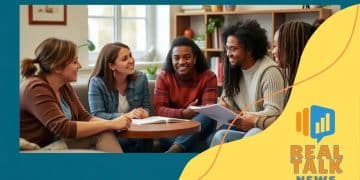Public Loan Forgiveness Changes That Help You Qualify

The Public Service Loan Forgiveness program allows eligible borrowers to have their federal student loans forgiven after making 120 qualifying payments while working full-time for a government or non-profit organization.
Public service loan forgiveness program changes have shifted the landscape for many borrowers. Are you aware of these updates?
They might just help you erase your student debt faster than you ever thought possible.
Understanding the public service loan forgiveness program
The public service loan forgiveness program is a valuable initiative for those dedicated to careers in government or non-profit sectors. It aims to provide relief for qualified borrowers by forgiving their federal student loans after a certain period of consistent payments.
Understanding this program is essential, as it can alleviate financial burdens and encourage commitment to public service. Many people remain unaware of how the program works.
You need to meet specific criteria to benefit. Candidates must work full-time by qualifying employers and have made 120 qualifying monthly payments under a qualifying repayment plan. This can significantly reduce your remaining loan balance.
Eligibility requirements
To ensure you qualify, consider these key points:
-
You must work for a government organization or a non-profit that operates tax-exempt under Section 501(c)(3).
-
Payments must be made under a qualifying repayment plan, such as the Income-Driven Repayment Plan.
-
Full-time employment is a must; you should work at least 30 hours per week.
Once you understand the criteria, the next step involves maintaining organized documentation. Keep track of your employment, payments, and any necessary paperwork.
This organization can help you move more smoothly through the forgiveness process.
How to apply for forgiveness
After meeting all eligibility requirements, you can submit your application for forgiveness. This process generally takes about 60 days for a decision.
If approved, borrowers will no longer need to make any additional payments. However, if you’re denied, you can appeal the decision.
Be prepared to provide any supporting documentation required to strengthen your application.
Recent changes to the program

Recent updates to the public service loan forgiveness program have made significant strides in addressing previous limitations and expanding eligibility. These changes are crucial for borrowers seeking relief.
The most notable changes include a temporary waiver that allows past payments to count toward forgiveness, even if they were made under non-qualifying repayment plans.
This adjustment helps borrowers retroactively qualify for forgiveness and receive much-needed financial relief.
Expanded eligibility criteria
With recent modifications, the eligibility requirements have become more inclusive. Here are some key points to consider:
-
Borrowers who previously did not qualify due to faulty payment classifications may now find their payments counted.
-
Employment with a broader range of non-profit organizations is now recognized.
-
Temporary expansions of eligibility for loans that were previously ineligible for forgiveness.
The program now recognizes payments made during deferment or forbearance. Even paused payments may count toward the total required.
These enhancements open the door for many professionals committed to public service.
Application processes simplified
The application process has also seen improvements. Simplified forms and clearer guidelines help applicants submit requests more efficiently.
This means less confusion and faster procedures for those pursuing forgiveness. Staying informed is vital as the program continues to evolve.
Remaining updated on program changes and requirements can make a significant difference in successfully achieving full loan discharge.
Eligibility requirements you should check
Knowing the eligibility requirements for the public service loan forgiveness program is essential for anyone looking to benefit from it. There are specific criteria to meet.
First, borrowers must be employed full-time by a qualifying employer. This includes government and non-profit organizations that are tax-exempt under Section 501(c)(3).
If you’re unsure whether your employer qualifies, check with the U.S. Department of Education for verification.
Key requirements
Here are vital eligibility factors to consider:
-
Employment at a qualifying organization must be full-time, which generally means working at least 30 hours per week.
-
You must have federal student loans. Private loans do not qualify for this program.
-
Payments must be made under a qualifying repayment plan, like Income-Driven Repayment. Having made 120 qualifying payments is also crucial.
Alongside these basic rules, keep careful records of your payment history and employment. Documentation is key.
It ensures you’re ready to provide proof and improve your chances of securing loan forgiveness.
How to apply for loan forgiveness
Applying for loan forgiveness can seem daunting, but understanding the steps can simplify the process. Once you meet eligibility requirements, you can begin.
This crucial step can help reduce your student debt and offer financial peace of mind. Preparation is key.
Gather all necessary documents that support your application. Include proof of employment, payment history, and any other relevant records.
Steps to apply for forgiveness
Here’s a clear breakdown of the application process:
-
Complete the Public Service Loan Forgiveness (PSLF) application form accurately.
-
Submit your application to your loan servicer along with supporting documents.
-
Follow up with your servicer to ensure they received your application and check for any missing documents.
Expect to wait around 60 days for a response after submission. Your servicer will evaluate your eligibility and documentation.
If denied, you have the right to appeal by submitting additional evidence or correcting any errors or missing details in your file to strengthen your case.
Tips for a successful application
Keep these tips in mind to improve your chances:
-
Double-check all forms for accuracy before submission.
-
Stay organized to keep track of documents and communications with your loan servicer.
-
Make sure to consolidate your loans if necessary, as this can affect eligibility.
These strategies can help you stay on track throughout the entire application process and avoid common mistakes that delay forgiveness.
Being proactive at every stage is key to reducing stress, staying informed, and significantly increasing your chances of approval.
Tips for maximizing your forgiveness benefits

To get the most out of the public service loan forgiveness program, it’s essential to follow strategies that improve your chances. A smart approach makes the process smoother.
First, always keep accurate records of your payments and employment. Obtain documentation from your employer to prove that you meet the necessary requirements.
Having this organized information can expedite your application and strengthen your case.
Best practices for maximizing benefits
Here are some helpful practices:
-
Enroll in a qualifying repayment plan. Consider an Income-Driven Repayment plan, as it allows lower monthly payments that may count toward forgiveness.
-
Stay up-to-date on changes to the program. New updates can affect eligibility, so regularly check the official PSLF website for the latest information.
-
File your application even if you think you might not qualify. Sometimes changes can impact eligibility after submitting.
Keep regular communication with your loan servicer. Ask questions and clarify details you’re unsure about.
This approach helps prevent mistakes and ensures accurate, timely decisions.
In summary, the public service loan forgiveness program offers significant opportunities for eligible borrowers to relieve their student debt while serving the community.
By understanding the requirements, staying organized, and following the application processes, you can maximize your benefits.
Remember to keep yourself updated on any changes, maintain clear records, and actively engage with your loan servicer. Taking these steps can lead you closer to financial freedom.
FAQ – Frequently Asked Questions about Public Service Loan Forgiveness
Who qualifies for the public service loan forgiveness program?
To qualify, borrowers must work full-time for a government or non-profit organization and make 120 qualifying payments under a qualifying repayment plan.
How do I apply for loan forgiveness?
To apply, complete the Public Service Loan Forgiveness application and submit it to your loan servicer along with the required documentation.
What types of loans are eligible for forgiveness?
Only federal student loans, such as Direct Loans or Federal Family Education Loans (FFEL), are eligible for forgiveness. Private loans do not qualify.
Can I count previous payments made before applying?
Yes, under certain conditions, previous payments made may count toward the 120 required for forgiveness, especially if they were made under qualifying repayment plans.





